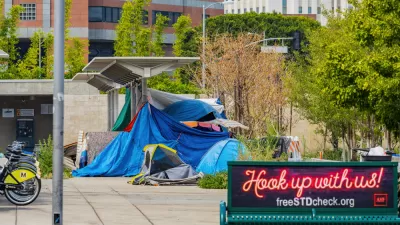Even as extensions to the Gold Line and Measure S seem to paint a brighter future for public transit in Los Angeles, commuters continue to use less public transit, especially buses.

"Since 2009, Metro has opened four new rail extensions at a cost of more than $4 billion. In the same period, rail ridership soared 21%, but bus trips — a much larger share of overall ridership — dropped 18%," writes Laura J. Nelson for the Los Angeles Times.
The reasons for the shrinking use of transit are multiple, according to Nelson's reporting. One is the complexity of serving a city with so many different commerce centers, which requires compromises in bus service. "But tweaks over the years to routes and schedules may have eroded the efficiency of some workhorse bus lines that serve major corridors, or made the routes more confusing for riders," Nelson writes. Nelson also reports that some transit experts see falling bus ridership as a side effect of an improving economy. "As L.A.’s economy has steadily improved, traffic has grown worse, and so has Metro’s on-time performance. Agency figures show that about 76% of buses arrived on time in the 2014 fiscal year." Ride sharing services may be partly to blame as well.
One reason for the decline in bus ridership Nelson does not cite is zoning and density. There's been much talk about how although L.A.'s downtown is becoming more popular, it's hard to build large dense transit-friendly buildings in the city. This phenomenon is noticeable by how few cranes you see in the city's downtown compared to even smaller, slower-growing cities like Chicago. Density continues to be on the minds of many as Measure S and the possibility of stalling the construction of more and taller residential and business buildings looms.
FULL STORY: The Metro can take you farther than ever. Here's why ridership dropped — again

Alabama: Trump Terminates Settlements for Black Communities Harmed By Raw Sewage
Trump deemed the landmark civil rights agreement “illegal DEI and environmental justice policy.”

Planetizen Federal Action Tracker
A weekly monitor of how Trump’s orders and actions are impacting planners and planning in America.

The 120 Year Old Tiny Home Villages That Sheltered San Francisco’s Earthquake Refugees
More than a century ago, San Francisco mobilized to house thousands of residents displaced by the 1906 earthquake. Could their strategy offer a model for the present?

BLM To Rescind Public Lands Rule
The change will downgrade conservation, once again putting federal land at risk for mining and other extractive uses.

Indy Neighborhood Group Builds Temporary Multi-Use Path
Community members, aided in part by funding from the city, repurposed a vehicle lane to create a protected bike and pedestrian path for the summer season.

Congestion Pricing Drops Holland Tunnel Delays by 65 Percent
New York City’s contentious tolling program has yielded improved traffic and roughly $100 million in revenue for the MTA.
Urban Design for Planners 1: Software Tools
This six-course series explores essential urban design concepts using open source software and equips planners with the tools they need to participate fully in the urban design process.
Planning for Universal Design
Learn the tools for implementing Universal Design in planning regulations.
Clanton & Associates, Inc.
Jessamine County Fiscal Court
Institute for Housing and Urban Development Studies (IHS)
City of Grandview
Harvard GSD Executive Education
Toledo-Lucas County Plan Commissions
Salt Lake City
NYU Wagner Graduate School of Public Service





























